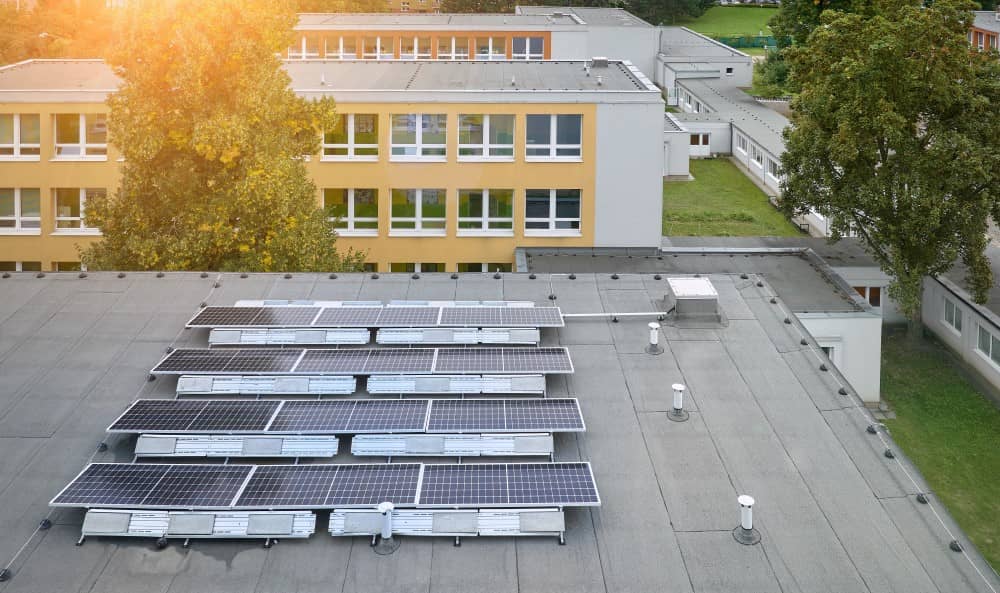Australia has become one of the world’s leaders in solar power adoption. Thanks to the abundance of sunshine and favourable government schemes, it’s easy to see why more and more businesses choose to go solar.
The increase in Australia’s solar installation has been significant over the last few years, with around 3,500 MW of solar installed in commercial and industrial properties as of 2021, according to the Australian Energy Council.
As the commercial sector looks to reduce its carbon footprint, solar has indeed become an excellent solution to achieve this goal whilst lowering energy costs.
The Benefits of Commercial Solar Power
The electricity demand will never decrease. With the significantly high fuel prices and rising concern for the environment, businesses are now resorting to alternative energy sources. One of which is solar power, a more sustainable choice with a variety of applications. Here are some of the crucial benefits businesses can gain from going solar in 2023:
1. Reduced Operating Costs
No matter the environmental impact of the business, choosing to go solar is usually about saving money. PV solar was once expensive that only big company names could afford. Today, it is more affordable than ever, making it an accessible energy source for any organisation, regardless of size.
Solar allows businesses to own a power-generating asset. It’s a better and cheaper alternative to continuously paying utility companies. By installing commercial solar, a business can become its electricity supplier. It can gain the opportunity to prepay for several years of energy at a fraction of the current costs of electricity.
2. Return on Investment
Spending money on a solar system and its installation is an investment. For one, it offers a good ROI through energy savings, as mentioned above. The Australian government also provides several incentives and programs for installing commercial solar, including the Small-scale Renewable Energy Scheme (SRES) for systems smaller than 100kW and the Large-scale Renewable Energy Target (LRET). Businesses may be qualified for tax benefits, such as investment tax credits and accelerated depreciation.
More often than not, payback usually happens in five years or less. If that’s still not enough reason to go solar, taking advantage of renewables can increase property value, as well. This additional return on investment can make a business appear more attractive to potential customers, clients, buyers, or tenants.
3. The Green Label
Any business demonstrating its commitment to environmental responsibility and sustainability earns the coveted “green” label. Many consumers are now prioritising green and eco-friendly companies. If you decide to install a solar power system, you’re not only saving money on electricity bills but also generating electricity from a clean and renewable source.
Another reason to install commercial solar is the chance to obtain certifications, including Leadership in Energy and Environmental Design (LEED) and Building Research Establishment Environmental Assessment Method (BREEAM).
4. Reduced Carbon Footprint
The traditional way of generating electricity is to burn fossil fuels, such as natural gas, coal, and oil. Unfortunately, this method releases greenhouse gases, including methane, nitrous oxide, and carbon dioxide, which contribute to many problems like climate change.
In contrast, solar systems rely on the power of the sun. No gaseous matter is released into the atmosphere, making solar a clean and sustainable energy source. Switching to solar can dramatically decrease a business’s carbon footprint, which refers to the number of greenhouse gases produced.
Also, solar systems are durable and have long lifespans. Therefore, businesses decrease their dependence on traditionally produced electricity for many years, resulting in carbon footprint reduction.
5. Protection from Future Electricity Cost Increases
Electricity prices fluctuate due to several reasons, including market demand and fuel prices, among other factors. These changes can be unpredictable and can lead to a considerable hike in electricity costs. Combat that by installing solar, which provides a stable and predictable source of electricity.
Businesses reduce their grid reliance when they can generate their electricity. That means there’s greater control over the energy supply, which therefore insulates the company from future price increases of electricity. Think about it; the electricity generated is technically free after the initial installation cost. It’s one of the best ways to achieve cost savings and financial stability in the long term.
Understanding The Costs of Commercial Solar
Commercial solar costs can vary greatly depending on a variety of factors. Before installation, you will be provided with a quote that considers the size of the system, your location, the components, and brand and quality.
Small systems ranging from 10kW to 50kW can start at $10,000 but can go up to $50,000. A small system is recommended for small businesses with low to moderate electricity requirements. Meanwhile, if you wish to have a larger system, the cost can typically go from $50,000 to $100,000. You can say that the typical solar price in Australia is usually around $1,000 per kW but can go up to $1,300 per kW in some cases.
If you add power optimisers, microinverters, and other add-ons, you’ll get 15-20% on top of the regular cost. You can avoid that additional charge by choosing the standard way, which is to use a string or central inverter system.
Here’s a trick, though. Installing up to 30kW can save you up to $300 per kW. That’s because smaller commercial solar does not require a ton of network protection. Moreover, the associated engineering costs are much lower than bigger systems.
Installation And Maintenance Considerations
Commercial solar installation requires planning. These systems are enormous, unlike residential solar, which generally has about 18 to 24 panels for a 6.6kW system. They can range anywhere from 30kW (100 300-watt panels) to 100kW (333 300-watt panels). Here are some important considerations when installing commercial solar:
- Location: Ensure that the panels are placed in a spot that receives maximum sunlight throughout the day to produce the promised amount of electricity.
- Roof Structure: Because you will be dealing with hundreds, if not more, panels, the roof should be solid and durable to support the weight of the panels. Its robustness is also crucial in withstanding weather and wind conditions.
- Permits: In general, a business should first obtain approvals and permits from its local council. A reputable installer can take this burden off your shoulders.
- Components: Never go cheap when it comes to your solar system’s components. Make sure you buy quality panels and inverters designed for commercial use.
After installation, a few necessary steps must be taken to guarantee the efficiency and performance of your solar system. Maintaining the system is as important as the installation process. Aside from regularly cleaning, you should also do the following:
- Monitoring: Commercial solar should constantly be monitored to ensure the system operates at its peak efficiency. That means you have to check the individual panels from time to time while also assessing the solar system’s overall energy production. It’s crucial to purchase a system that includes monitoring of solar energy and electricity consumption. That way, you can keep track of your electricity bills and figure out how to make them even lower with the use of your solar system.
- Inverter Care: Solar panels are not the only ones that require your attention. You should not neglect the inverter, which is a critical element of the system. Look for faults, keep it cool, and ensure it is clean. If its components are not functioning properly, you should replace them right away.
- System Inspection: A qualified technician should regularly inspect commercial solar. That way, potential issues can be avoided or rectified before becoming more serious. The technician will usually check the electrical system, including the grounding of the solar panels and wire connections. Inspection may include the inverter, PV modules, electrical boxes, utility power, and conductors.
It helps to adopt a maintenance schedule, which is generally provided by the installer, as required by the Clean Energy Council. If you have a larger-than-normal commercial system, your installer may offer a comprehensive and customised schedule, usually every six months for the first two years.
The Future of Commercial Solar
The future looks bright for commercial and industrial solar in Australia. More and more businesses are expected to invest in solar, especially with the continued cost reductions of these systems. Solar power costs are on a downward trend and will likely remain for several years.
Solar technology will keep improving, making competing with traditional fossil fuel-generated electricity more viable. Like residential solar, commercial solar is rapidly advancing towards battery storage technology. Most businesses opt to integrate batteries with their solar systems to maximise the benefits of solar. Batteries allow for storing excess energy during the day, which can be used at night or when there’s insufficient sunlight. Battery storage further reduces a business’ reliance on grid electricity, which is one thing that clever entrepreneurs want to take advantage of.
Finally, the Australian government announced its commitment to achieving net-zero emissions by 2050. For this goal to be realised, a range of policies and incentives were introduced to encourage more people and establishments to transition to renewable energy. The current Large-Scale Renewable Energy Target will likely continue to provide support for the growth of commercial solar in the country.
Choosing a Solar Provider
One of the first things you should look for in a solar provider is their Clean Energy Council accreditation. Without this qualification, you will not enjoy any rebates and subsidies available in your location. Aside from that, being CEC-accredited means that you can be confident that the installer has the required training and experience to ensure a safe installation of your commercial solar system.
Other considerations include the following:
- Total Cost: Remember that you get what you pay for with solar. You can’t expect superior performance from a cheap system. It is an investment, after all. You will depend on this system for 15 years or more, so you must be paying for commercial solar that you will be happy with.
- Warranties: All solar panels degrade yearly, regardless of their quality, brand, and price. The difference is in the degree since top-quality panels degrade just a tiny amount. Nevertheless, getting a performance guarantee from the supplier that covers panel performance for 15-20 years is still necessary. Inverters, on the other hand, should carry at least a five-year warranty. However, if you could get a 10-year warranty, that would be ideal.
- Craftsmanship: Experience is a must, but craftsmanship is a huge bonus. A properly-installed commercial can beautify your facilities. A good installer will use a mounting system that will not make your building hideous, especially with panels overhanging on the roof’s edge. Cables should be neatly arranged and protected, so they not only last for several years but also look tidy.
You can beat the rising costs of electricity with the help of commercial solar from a reputable supplier like Aus Energy Solar. Contact us for a customised solution that best fits your facility and electricity requirements.





